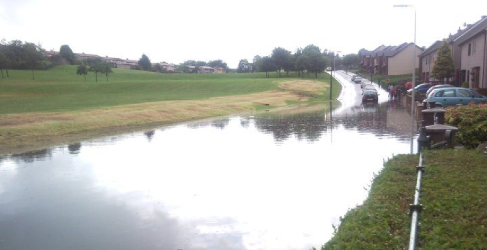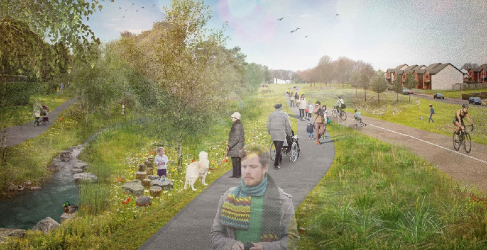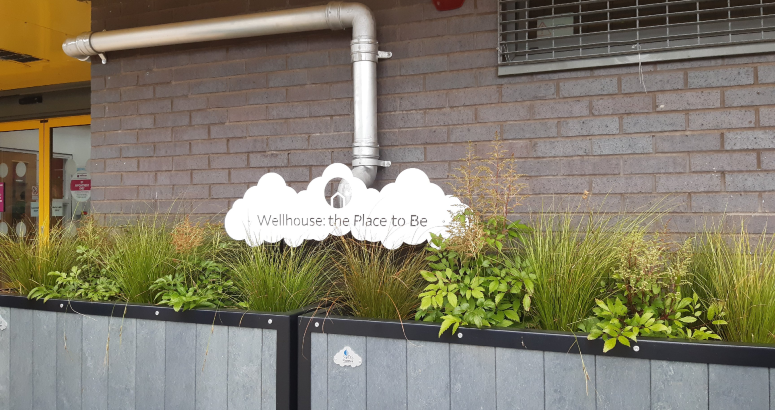Scottish Water Turns to Nature to Create Rainproof Communities
05 March 2024It is investing in solutions using the natural environment - often called ‘blue green’ infrastructure - on a range of pilot projects across Scotland.
The projects combine natural features such as ponds, wetlands, swales, green roofs, raingardens, restored river channels, trees and property-level planters and water butts with engineered solutions like pipes and drains.

St Leonard Park in Dundee is regularly affected by flooding.

The introduction of nature-based solutions could help tackle flooding in St Leonard Park, and at other locations across Scotland (simulated image).
Grant Vanson, leading the nature-based approach at Scottish Water, said: “By reducing the amount of rainwater that enters the sewer system we can reduce the frequency and severity of flooding from the sewer network.
“Scotland is facing increasing challenges from extreme weather events and climate change. We’ve all noticed the increase in the number of storms, rainfall, and flooding events.“Our traditional drainage systems are not designed to cope with such volumes, so we must look at a more sustainable and holistic approach to managing rainwater.”
Grant Vanson
Technical Team Leader - Flood Risk Management
“Our traditional drainage systems are not designed to cope with such volumes, so we must look at a more sustainable and holistic approach to managing rainwater.
“We will always need pipes in the ground, but we can support this infrastructure with natural features and processes to manage rainwater and create more attractive and healthy places for people and wildlife for both current and future generations.”
Urban creep has become an increasing cause of flooding within communities. That’s when green spaces that would naturally soak up water are being removed and replaced with impermeable surfaces such as flagstones, block paving, tarmac or concrete.
A growing number of places across the world are now looking to harness nature and use nature-based solutions to tackle climate change.
‘Sponge cities’ are springing up everywhere from Shanghai, and New York, to Cardiff. These urban sprawls have an abundance of natural areas such as trees, lakes and parks, drainage pavements, rain gardens, green walls, and roofs to absorb rain and prevent flooding.
In Scotland, the Scottish Government is committed to encouraging and adopting a blue green approach to create ‘water resilient places’ as part of their surface water management strategy.
Publicly owned, Scottish Water is also committed to delivering the best service to its customers and protecting the environment and is now introducing more of these nature-based approaches, alongside its traditional infrastructure.

Rain Gardens
Rain gardens, like this one at a community building in Glasgow, are just one of the nature-based solutions being proposed to help manage rainwater and tackle flooding in communities across Scotland.
Working with local authorities, Scottish Environment Protection Agency, NatureScot, and other stakeholders, several different opportunities have been identified across the country.
Some of the proposals being led or supported by Scottish Water which are already underway or being developed include:
- Disconnection of surface water from the sewer network into raingardens and trees at Scottish Water’s Dundee office.
- Creating a network of rain gardens, planters, and permeable paving in Glasgow's West End to manage surface water from 85 hectares of urban land.
- Transforming a former golf course in Paisley into a public park with wetlands, woodlands and meadows that can store up to 57 Olympic-sized swimming pools of water during storms.
- Restoring the natural course of the Bannock Burn in Stirling and enhancing its floodplain with native vegetation and wildlife habitats.
- Creating a network of swales, basins, and ponds to manage stormwater runoff from new housing developments in Countesswells, Aberdeen.
- Installing green roofs, rain gardens and permeable paving to capture and reuse rainwater, improve drainage, and increase biodiversity in the Gorbals, Glasgow.
- Restoring the White Cart Water river corridor and creating a series of wetlands, woodlands and meadows to enhance the natural flood plain, provide ecological and amenity benefits, and reconnect the river with the town centre in Paisley.
- Developing a blue green corridor along the Water of Leith in Edinburgh, connecting existing green spaces, and improving biodiversity and water quality.
- Installing property-level water butts and rain planters in a Prestwick neighbourhood. The creation of “pocket-parks” to provide community greenspace and water resilience in Dundee.
These projects will not only improve the ‘sponginess’ of these communities, but they will also deliver a multitude of other benefits.
By harnessing the power of nature, Scottish Water hopes to create a more resilient, sustainable, and beautiful Scotland for the future and wants everyone to get involved using this approach in their own homes and neighbourhoods.
Grant added: “Introducing blue green infrastructure will result in reduced flooding risks, enhanced environmental quality, and more attractive and liveable places.
“We believe this will contribute to making Scotland, healthier, greener, fairer, and more prosperous, supporting our vision for a sustainable future.
“There are simple things everyone can do, like planting trees, installing water butts, creating rain gardens or green roofs, or joining a community group can make a difference in reducing surface water and improving the environment.”









